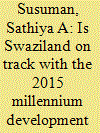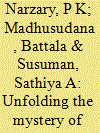| Srl | Item |
| 1 |
ID:
155797


|
|
|
|
|
| Summary/Abstract |
This study aimed to examine the relationship between maternal health and good quality of life in an attempt to understand the years between 2005 and 2011. Data from the Ethiopia Demographic and Health Surveys 2005 and 2011 were used. Bivariate, Camer-V, chi-square and logistic regression analyses were used to determine the relative contribution of the predictor variables. The hypotheses tested in this study were that gender, wealth quintile, type of place of residence and region are highly significant with women’s education and work status. Females’ expected age (adjusted odds ratio = AOR) for some school training has dropped in 2011 from 0.678 to 0.255 for the age group 25–34, but male expected age (AOR) for some school has increased in 2011 from 0.784 to 2.274. The age of the respondent, age at first cohabitation and socio-economic variables were positively associated with having visited health facilities in the last 12 months and being visited by a family planning worker.
|
|
|
|
|
|
|
|
|
|
|
|
|
|
|
|
| 2 |
ID:
157191


|
|
|
|
|
| Summary/Abstract |
According to the Millennium Development Goals (MDGs) agreement, each participating country has to periodically provide a report that will show the progress on their achievement towards the goals. This article’s aim is to evaluate Swaziland’s prospects of achieving eight MDGs by 2015. This article is an analysis of the current situation of Swaziland, and the aim of this analysis is to look beyond the statistical values to see if the achievements (including lifetime achievements) are on track and whether what is yet to be achieved can really be achieved. Secondary information was collected from various sources. Several countries and organizations have committed themselves to the following eight development goals: (1) eradicate extreme poverty; (2) achieve universal primary education; (3) promote gender equality and empower women; (4) reduce child mortality; (5) improve maternal health; (6) combat HIV/AIDS, malaria and other diseases; (7) ensure environmental sustainability; and (8) develop a global partnership for development. National development is dependent on many factors; therefore, different countries across the world have adopted the MDGs as means of alleviating many of the social ills hindering progress and development. Based on different sources, Swaziland is on track with its MDGs, and there is no doubt that Swaziland will continue to work hard to these ends. It has been argued that there has been progress made that has resulted in significant changes to people’s lives, but the question that has to be asked is how long these achievements can realistically last. A reduction of the rate of child mortality, maternal mortality and HIV/AIDS in Swaziland are needed.
|
|
|
|
|
|
|
|
|
|
|
|
|
|
|
|
| 3 |
ID:
155167


|
|
|
|
|
| Summary/Abstract |
Reliance on traditional methods of birth control causes psychological tension in couples because the fear of unwanted pregnancy bars them from experiencing a healthy sexual life. However, in Assam, half of all contraceptive users depend on traditional methods of birth control. The current study used National Family Health Survey 2005–2006 data. Out of 3840 sample women in the age group 15–49 years, 1286 women are filtered for the present study. Most of the demographic and socioeconomic characteristics of traditional method users fall between those of modern spacing method users and terminal method users. Thus, the burden of unwanted fertility is highest among the traditional method users.
|
|
|
|
|
|
|
|
|
|
|
|
|
|
|
|